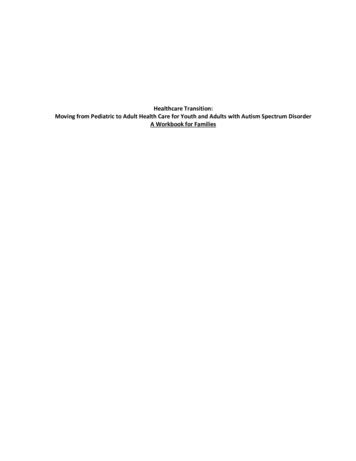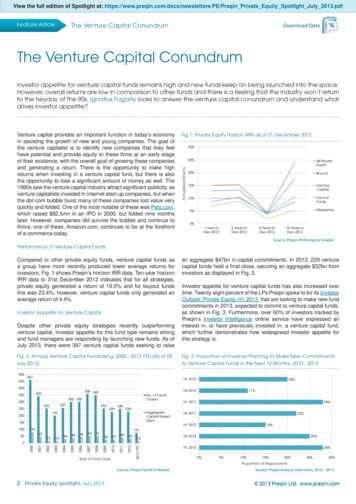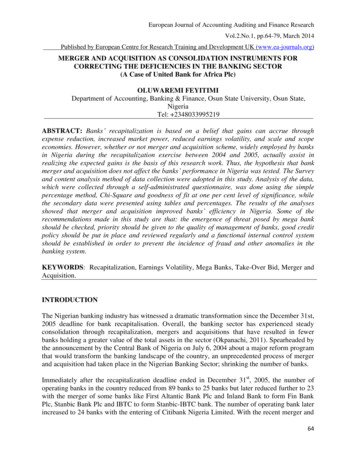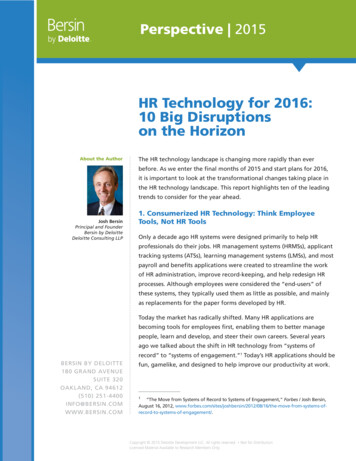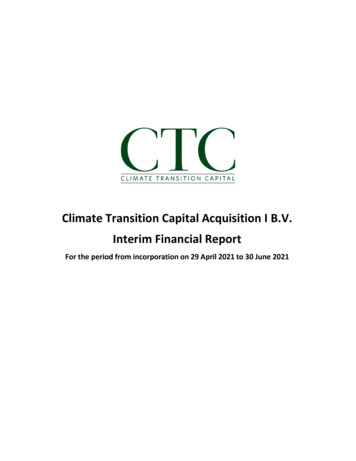
Transcription
Climate Transition Capital Acquisition I B.V.Interim Financial ReportFor the period from incorporation on 29 April 2021 to 30 June 2021
ContentsPageChair’s Report2Interim Board Report3-4Interim Financial StatementsStatement of Financial Position5Statement of Comprehensive Income6Statement of Changes in Equity7Statement of Cash Flow8Notes to the Interim Financial Statements9 - 18Contact Information191
Chair’s ReportOn 30th June 2021, Climate Transition Capital listed its first special purpose acquisition company (SPAC),Climate Transition Capital Acquisition 1 B.V. on the Euronext Amsterdam exchange, raising 190 million.Our Mission at Climate Transition Capital is to mobilise capital to accelerate the climate transition and tolimit global temperature increases to 1.5 C. We believe that the public capital markets can play a muchmore significant role to finance the climate transition. According to the IEA and IRENA, annual investmentlevels of 3 trillion to 5 trillion will be needed, which will have to be met largely through public equitymarkets.SPACs can be an effective vehicle to address this funding gap by offering promising climate transitioncompanies efficient access to those public markets, with the support of blue chip investors.At Climate Transition Capital, we are focused on opportunities in decarbonising energy, decarbonisingtransport and decarbonising industry, particularly in sectors like shipping, cement or steel productionwhich present a real challenge for CO2 reduction but account for half of all global emissions. These sectorshave so far seen limited investment in comparison to mature renewable energy technologies like windand solar.Since the IPO, our investment team at Climate Transition Capital has been busy reviewing the Europeanclimate transition landscape and has confirmed that there are a significant number of opportunities. Ourinvestment team is making excellent progress and I look forward to continuing to discuss our businesspartner options with them and the Board.Since the listing, we have also seen the sixth report published by the UN’s Intergovernmental Panel onClimate Change (IPCC), which was signed off by 234 scientists from more than 60 countries. The reportwarns that the world is likely to reach 1.5 C of warming within 20 years, even in a best-case scenario ofdeep cuts in greenhouse gas emissions.The report states that, even with rapid emissions cuts, temperatures would continue to rise until at least2050 and lead to further extreme weather events. It concluded that without immediate, rapid and largescale reductions in emissions, curbing global warming to either 1.5 C or even 2 C above pre-industriallevels by 2100 would be beyond reach. UN secretary-general António Guterres described the conclusionsas “a code red for humanity”.Meanwhile, the effects of human-driven climate change have become increasingly apparent over thesummer: Europe recorded its hottest-ever temperature in August when it reached 48.8 C in Italy, wildfirestore across the Mediterranean region from Turkey to Spain, and floods wreaked havoc in Germany,Belgium, the Netherlands and Luxembourg.These extreme weather events followed what has already been declared by global insurers as the secondworst insured first-half year loss on record. The IPCC tells us that such extreme weather events willbecome more frequent and intense with each fraction of a degree of warming.As a result, Climate Transition Capital’s mission is of the utmost importance and urgency. I am confidentthat the team has the skills and experience to rise to this challenge and to bring to market an excitingclimate transition pioneer that will make a significant contribution to climate change mitigation whiledelivering strong financial returns to its investors.Marieke BaxChair, Climate Transition Capital Acquisition I B.V.2
Interim Board ReportOVERVIEWThe Company is a special purpose acquisition company (SPAC) incorporated for the purpose of effectinga merger, capital stock exchange, asset acquisition, stock purchase, reorganisation or similar businesscombination with or acquisition of a target business or entity (a Business Combination).During the period from 29 April 2021 up to and including 30 June 2021 (the "Period"), Climate TransitionCapital Acquisition I B.V. (“CTCA1” or the “Company”) successfully completed a private placement of19,000,000 “Units”, each entitling the holder to one Ordinary Share and one-third of a Warrant, at aprice of 10.00 per Unit raising 190 million (the “Offering”). The resulting Units were admitted to listingand trading on Euronext Amsterdam. On 4 August 2021, 35 calendar days after the first day of trading,the Units split into Ordinary Shares and Warrants which have been separately listed and traded onEuronext Amsterdam since.More information about the Company, including the Company's Initial Public Offering Prospectus dated23 June 2021 (the "Prospectus"), which was approved by the Dutch Authority for the Financial Markets,the AFM, can be found on the Climate Transition Capital tor-resources/CTCA1 is now actively targeting a Business Combination in the climate transition sector and has 24 monthsfrom the settlement date of 2 July 2021 to complete the process.FINANCIAL HIGHLIGHTS AS AT 30 JUNE 2021Proceeds receivable from the issue of UnitsFinancial liability relating to UnitsClosing price of Units on 30 June 2021 190.0m 186.7m 9.76COSTSAs part of the Offering the Sponsor committed capital of 10.5 million via the purchase of SponsorWarrants at a price of 1.50 each. 2 million of this amount will be used to cover up to 2 million ofnegative interest on the Escrow Account deposit (see below). The balance will be used to cover costsrelated to the Offering and the search for a Business Combination target. On completion of a BusinessCombination the Sponsor has the option to redeem for cash those Sponsor Warrants relating to anyunused portion of the 2 million interest rate cover.At 30 June 2021, total costs since the inception of CTCA1 amounted to 5.5 million, all of which relatedto company setup and Offering costs. These include 3.3m of underwriting fees.While the Company expects that it will have enough funds available to operate until the BusinessCombination deadline, it may sell up to 2 million additional Sponsor Warrants to the Sponsor at a price of 1.50 each to raise up to 3 million of additional capital, provided that such issuance is done for alegitimate business purpose (such as addressing any working capital requirements of the Company orfinancing any costs in connection with the pursuit of a Business Combination).ESCROW ACCOUNT100% of the proceeds of the Offering and the 2 million negative interest cover mentioned above havebeen put into an escrow account opened by Stichting Climate Transition Capital Escrow and held with3
ABN AMRO Bank N.V. in the Netherlands (the “Escrow Account”).The amounts available to CTCA1 from the Escrow Account (after the payment of any negative interest onamounts deposited in the Escrow Account and any repurchase of surplus “interest cover” SponsorWarrants) will be used to satisfy the cash requirements of the Business Combination, including payingunderwriting commission and other advisers’ fees relating to the initial offering which are conditional on aBusiness Combination, the Business Combination purchase price and related expenses and retainingspecified amounts to be used by the post-Business Combination company for working capital or otherpurposes.AUDITOR’S INVOLVEMENTThese interim financial statements have not been reviewed or audited by the Company’s statutoryauditor.RISKS AND UNCERTAINTIESPlease refer to the Risk Factors section of the Prospectus (pages 15 to 50) for the Company’s principalrisks and uncertainties, which in the Company's view remain essentially unchanged for the second half of2021, and to pages 58 and 59 of the Prospectus for a cautionary note regarding forward-lookingstatements. The Company's risk management objectives and policies are consistent with those disclosedin the Prospectus.Other risks, events, facts or circumstances not presently known to the Company, or that the Companycurrently deems to be immaterial could, individually or cumulatively, prove to be important and may havea significant negative impact on the Company’s business, financial condition, results of operations andprospects.RELATED PARTY TRANSACTIONSThe main related party transactions during the Period are those described on pages 121 and 122 of theProspectus.RESPONSIBILITY STATEMENTThe board of directors of the Company (the "Board") hereby declares that to the best of its knowledge,these interim financial statements, which have been prepared in accordance with IAS 34 (Interim FinancialReporting), give a true and fair view of the assets, liabilities, financial position and profit or loss of theCompany, and this interim Board report includes a fair review of the information required pursuant tosection 5:25d(8) and (9) of the Dutch Financial Supervision Act (Wet op het financieel toezicht).Amsterdam, 27 September 2021Marieke Bax, Chair and Independent Non-executive DirectorJoris Rademakers, Executive DirectorRobin Duggan, Executive DirectorDavid Buzby, Executive DirectorShaun Kingsbury, Non-executive DirectorDavid Crane, Non-executive DirectorDavid Tuohy, Independent Non-executive DirectorLisa McDermott, Independent Non-executive Director4
Statement of Financial PositionAs at 30 June 202130 June 2021(Unaudited) '00029 April 2021(Audited) '000190,00061190,061190,061-51(2,182)-Equity attributable to owners of the Company(2,131)-Total equityLiabilitiesUnitsOther payablesAccrualsCurrent liabilitiesTotal liabilitiesTotal equity and ,061-NotesAssetsProperty, plant and equipmentNon-current assetsTrade and other receivablesCash and cash equivalentsCurrent assetsTotal assets67EquityShare capitalRetained earningsNet Loss for the period5.15.28The notes on pages 9 to 18 form an integral part of the interim financial report.5
Statement of Comprehensive IncomeFor the period from incorporation on 29 April 2021 to 30 June 2021NotesOperationsRevenueCost of salesGross profitOther incomeAdministrative expensesOperating profitFinance incomeFinance costsNet finance costsProfit before taxIncome tax expenseProfit for the period8Period to30 June 2021(Unaudited) '000(2,182)(2,182)(2,182)(2,182)The notes on pages 9 to 18 form an integral part of the interim financial report.6
Statement of Changes in EquityFor the period from incorporation on 29 April 2021 to 30 June 2021Sharecapital(Unaudited) '000Sharepremium(Unaudited) '000Retainedearnings(Unaudited) '000Net loss forthe period(Unaudited) '000Total Equity(Unaudited) '000Balance at incorporation on 29 April 2021-----Total comprehensive lossLoss for the periodTotal comprehensive loss for the period---(2,182)(2,182)(2,182)(2,182)Transactions with owners, recorded directly in equityContributions and distributions:Shares issued5.1Total contributions and distributions5151---5151Total transactions with owners of the Company51---51Balance at 30 June 202151--(2,182)(2,131)NotesThe notes on pages 9 to 18 form an integral part of the interim financial report.7
Statement of Cash FlowFor the period from incorporation on 29 April 2021 to 30 June 2021NotesPeriod to30 June 2021(Unaudited) '000Cash flows from operating activitiesLoss for the periodIncrease in other payablesIncrease in accrualsNet cash from operating activities(2,182)102,18210Cash flows from investing activitiesNet cash from investing activities-Cash flows from financing activitiesProceeds from issue of share capitalNet cash flow from financing activities5151Net increase in cash and cash equivalentsNet cash and cash equivalents at 29 April 2021Net cash and cash equivalents at period end61617The notes on pages 9 to 18 form an integral part of the interim financial report.8
Notes to the Interim Financial Statements1. The company and its operationsClimate Transition Capital Acquisition I B.V. (hereinafter referred to as “CTCA1” or the “Company”) is aprivate limited liability company incorporated and domiciled in the Netherlands. The Company’s registeredoffice is at Prins Bernhardplein 200, 1097 JB Amsterdam. The Company was founded on 29 April 2021 and isregistered in the Trade Register at the Dutch Chamber of Commerce under number 82671788.The information in these interim financial statements has not been reviewed or audited by the Company’sstatutory auditor.2. Significant accounting policies2.1. Basis of preparationThe interim financial statements have been prepared in accordance with IAS 34 (Interim FinancialReporting).The Company’s first set of annual financial statements covering the period to 31 December 2021 will beprepared in early 2022 and will be in accordance with International Financial Reporting Standards ("IFRS")as endorsed by the European Union. Theses interim financial statements have been prepared inaccordance with the recognition and measurement requirements of IFRS, however they do not include allthe information required for full annual financial statements.The interim financial statements were authorised for issue by the Company's board of directors(the "Board") on 27 September 2021.2.2. Business combinations and goodwillBusiness combinations are accounted for using the acquisition method. The cost of an acquisition ismeasured as the aggregate of the consideration transferred, which is measured at acquisition date fairvalue, and the amount of any non-controlling interests in the acquiree. For each business combination,the Company elects whether to measure the non-controlling interests in the acquiree at fair value or atthe proportionate share of the acquiree’s identifiable net assets. Acquisition-related costs are expensedas incurred and included in administrative expenses.The Company determines that it has acquired a business when the acquired set of activities and assetsinclude an input and a substantive process that together significantly contribute to the ability to createoutputs. The acquired process is considered substantive if it is critical to the ability to continue producingoutputs, and the inputs acquired include an organised workforce with the necessary skills, knowledge, orexperience to perform that process or it significantly contributes to the ability to continue producingoutputs and is considered unique or scarce or cannot be replaced without significant cost, effort, or delayin the ability to continue producing outputs.When the Company acquires a business, it assesses the financial assets and liabilities assumed forappropriate classification and designation in accordance with the contractual terms, economiccircumstances and pertinent conditions as at the acquisition date. This includes the separation ofembedded derivatives in host contracts by the acquiree.Any contingent consideration to be transferred by the acquirer will be recognised at fair value at theacquisition date. Contingent consideration classified as equity is not remeasured and its subsequent9
settlement is accounted for within equity. Contingent consideration classified as an asset or liability thatis a financial instrument and within the scope of IFRS 9 Financial Instruments, is measured at fair valuewith the changes in fair value recognised in the statement of profit or loss in accordance with IFRS 9. Othercontingent consideration that is not within the scope of IFRS 9 is measured at fair value at each reportingdate with changes in fair value recognised in profit or loss.Goodwill is initially measured at cost (being the excess of the aggregate of the consideration transferredand the amount recognised for non-controlling interests and any previous interest held over the netidentifiable assets acquired and liabilities assumed). If the fair value of the net assets acquired is in excessof the aggregate consideration transferred, the Company re-assesses whether it has correctly identifiedall of the assets acquired and all of the liabilities assumed and reviews the procedures used to measurethe amounts to be recognised at the acquisition date. If the reassessment still results in an excess of thefair value of net assets acquired over the aggregate consideration transferred, then the gain is recognisedin profit or loss. After initial recognition, goodwill is measured at cost less any accumulated impairmentlosses. For the purpose of impairment testing, goodwill acquired in a business combination is, from theacquisition date, allocated to each of the Company’s cash-generating units that are expected to benefitfrom the combination, irrespective of whether other assets or liabilities of the acquiree are assigned tothose units.2.3. Foreign currenciesThese interim financial statements are presented in Euros, which is the Company’s functional andpresentation currency.Transactions denominated in currencies other than Euros are recorded at the exchange rate at thetransaction date.2.4. Financial instrumentsA financial instrument is any contract that gives rise to a financial asset of one entity and a financial liabilityor equity instrument of another entity. The Company recognises a financial asset or a financial liabilitywhen it becomes a party to the contractual provisions of the instrument. Purchases or sales of financialassets that require delivery of assets within the time frame generally established by regulation orconvention in the marketplace (regular way trades) are recognised on the trade date, i.e. the date thatthe Company commits to purchase or sell the asset.Financial assets: the Company classifies its financial assets as subsequently measured at amortised costor measured at fair value through profit or loss on the basis of both: the entity’s business model for managing the financial assets; and the contractual cash flow characteristics of the financial asset.The Company initially measures a financial asset at its fair value plus, in the case of a financial asset not atfair value through profit and loss, transaction costs.Financial assets measured at amortised cost: a debt instrument is measured at amortised cost if it is heldwithin a business model whose objective is to hold financial assets in order to collect contractual cashflows and its contractual terms give rise on specified dates to cash flows that are solely payments ofprincipal and interest on the principal amount outstanding. Financial assets at amortised cost aresubsequently measured using the effective interest rate (EIR) method and are subject to impairment.10
Gains and losses are recognised in profit and loss when the asset is derecognised, modified or impaired.The Company includes in this category cash and cash equivalents.Financial liabilities: the financial liabilities are classified, at initial recognition, as financial liabilities at fairvalue through profit or loss or financial liabilities at amortised cost.The Company’s financial liabilities include trade and other payables and certain financial instruments.All financial liabilities are recognised initially at fair value and, in the case of borrowings and payables, netof directly attributable transaction costs.Financial liabilities measured at amortised cost: after initial recognition, interest-bearing loans andborrowings are subsequently measured at amortised cost using the EIR method. Gains and losses arerecognised in profit or loss when the liabilities are derecognised as well as through the EIR amortisationprocess.Amortised cost is calculated by taking into account any discount or premium on acquisition and fees orcosts that are an integral part of the EIR. The EIR amortisation is included as finance costs in the statementof profit or loss.The Company includes in this category interest-bearing loans and borrowings and trade and otherpayables.Derecognition: a financial liability is derecognised when the obligation under the liability is discharged,cancelled or expired. When an existing financial liability is replaced by another from the same lender onsubstantially different terms, or the terms of an existing liability are substantially modified, such anexchange or modification is treated as the derecognition of the original liability and the recognition of anew liability. The difference in the respective carrying amounts is recognised in the statement of profit orloss.Impairment of financial assets: the Company has chosen to apply an approach similar to the simplifiedapproach for expected credit losses (“ECL”) under IFRS 9 to its financial assets. Therefore, the Companyrecognises a loss allowance based on lifetime ECLs at each reporting date. The Company’s approach toECLs reflects a probability-weighted outcome, the time value of money and reasonable and supportableinformation that is available without undue cost or effort at the reporting date about past events, currentconditions and forecasts of future economic conditions.2.5. Cash and cash equivalentsCash and cash equivalents in the statement of financial position comprise cash at banks and on hand andshort-term highly liquid deposits with a maturity of three months or less, that are readily convertible to aknown amount of cash and subject to an insignificant risk of changes in value. The carrying amounts ofthese approximate their fair value.For the purpose of the interim statement of cash flows, cash and cash equivalents consist of cash andshort-term deposits, as defined above, net of outstanding bank overdrafts as they are considered anintegral part of the Company’s cash management.11
2.6. Fair value measurementFair value is the price that would be received to sell an asset or paid to transfer a liability in an orderlytransaction between market participants at the measurement date. The fair value measurement is basedon the presumption that the transaction to sell the asset or transfer the liability takes place either: in the principal market for the asset or liability; or in the absence of a principal market, in the most advantageous market for the asset or liability.The principal or the most advantageous market must be accessible by the Company.The fair value of an asset or a liability is measured using the assumptions that market participants woulduse when pricing the asset or liability, assuming that market participants act in their economic bestinterest.A fair value measurement of a non-financial asset takes into account a market participant's ability togenerate economic benefits by using the asset in its highest and best use or by selling it to another marketparticipant that would use the asset in its highest and best use.The Company uses valuation techniques that are appropriate in the circumstances and for which sufficientdata are available to measure fair value, maximising the use of relevant observable inputs and minimisingthe use of unobservable inputs.All assets and liabilities for which fair value is measured or disclosed in the interim financial statementsare categorised within the fair value hierarchy, described as follows, based on the lowest level input thatis significant to the fair value measurement as a whole: Level 1 - Quoted (unadjusted) market prices in active markets for identical assets or liabilities; Level 2 - Valuation techniques for which the lowest level input that is significant to the fair valuemeasurement is directly or indirectly observable; Level 3 - Valuation techniques for which the lowest level input that is significant to the fair valuemeasurement is unobservable.For the purpose of fair value disclosures, the Company has determined classes of assets and liabilities onthe basis of the nature, characteristics and risks of the asset or liability and the level of the fair valuehierarchy, as explained above.2.7. ProvisionsProvisions are recognised when the Company has a present obligation (legal or constructive) as a resultof a past event, it is probable that an outflow of resources embodying economic benefits will be requiredto settle the obligation and a reliable estimate can be made of the amount of the obligation. When theCompany expects some or all of a provision to be reimbursed, for example, under an insurance contract,the reimbursement is recognised as a separate asset, but only when the reimbursement is virtuallycertain. The expense relating to a provision is presented in the statement of profit or loss net of anyreimbursement.If the effect of the time value of money is material, provisions are discounted using a current pre-tax ratethat reflects, when appropriate, the risks specific to the liability. When discounting is used, the increasein the provision due to the passage of time is recognised as a finance cost.12
2.8. TaxesIncome tax recognised in the statement of profit or loss and other comprehensive income includes currentand deferred taxes.Current taxCurrent income tax assets and liabilities are measured at the amount expected to be recovered from orpaid to the taxation authorities. The tax rates and tax laws used to compute the amount are those thatare enacted or substantively enacted at the reporting date in the countries where the Company operatesand generates taxable income.Current income tax relating to items recognised directly in equity is recognised in equity and not in thestatement of profit or loss and other comprehensive income.Deferred taxDeferred tax is recognised on temporary differences between the carrying amounts of assets and liabilitiesin the interim consolidated financial statements and the corresponding tax bases used in the computationof taxable profit.Deferred tax liabilities are generally recognised for all taxable temporary differences. Deferred tax assetsare generally recognised for all deductible temporary differences to the extent that it is probable thattaxable profits will be available against which those deductible temporary differences can be utilised.Deferred tax assets are tested for impairment on the basis of a tax planning derived from managementbusiness plans.Such deferred tax assets and liabilities are not recognised if the temporary difference arises from goodwillor from the initial recognition (other than in a business combination) of other assets and liabilities in atransaction that affects neither the taxable profit nor the accounting profit.Sales taxThe Company is considered a VAT entrepreneur for the Dutch Tax Authorities.Expenses and assets are recognised net of the amount of sales tax, except: when the sales tax incurred on a purchase of assets or services is not recoverable from the taxationauthority, in which case, the sales tax is recognised as part of the cost of acquisition of the asset oras part of the expense item, as applicable; when receivables and payables are stated with the amount of sales tax included.The net amount of sales tax recoverable from, or payable to, the taxation authority is included as part ofreceivables or payables in the statement of financial position.3. EstimatesThe preparation of the interim financial statements requires management to make judgements, estimatesand assumptions that affect the application of accounting policies and the reported amounts of assets andliabilities, income and expenses. Actual results may differ from these estimates.Estimates and underlying assumptions are reviewed on an ongoing basis. Revisions to accounting estimatesare recognised in the period in which the estimates are revised and in any future periods affected.13
As at 30 June 2021, the significant areas of estimation, uncertainty and critical judgements in applyingaccounting policies that have the most significant effect on the amounts recognised in these interimconsolidated financial statements are: the accounting treatment and valuation of Sponsor Shares, Sponsor Warrants and Units (entitling theholder to one Ordinary Share and one third of a Warrant) (see note 5 below); deferred tax asset: a deferred tax asset in respect of the tax losses incurred has not been recognised asthe Board estimates uncertainty in terms of future taxable profit against which the Company can utilisethe benefits therefrom.4. Financial risk managementThe Company manages the financial risks relating to the operations through internal risk controls andmeetings which analyse exposures by degree and magnitude of risks. These financial risks might includeprincipally market risk, liquidity risk and credit risk.The Company's risk management objectives and policies are also consistent with those disclosed in theProspectus.Market risk managementCTCA1 is primarily exposed to the financial risks of changes to interest rates. During the Period, there hasbeen no change to the Company’s exposure to market risks or the manner in which these risks are managedand measured.Liquidity risk managementThe Company’s liquidity needs have been satisfied through receipt of the 10.5 million proceeds from thesale of Sponsor Warrants shortly after the settlement of the Offering, which after payment of the negativeinterest cover, company set-up and Offering costs will leave cash available in the current account of 3.0million.While the Company expects that it will have enough funds available to operate until the BusinessCombination deadline, it may sell up to 2 million additional Sponsor Warrants to the Sponsor at a price of 1.50 each to raise up to 3 million of additional capital, provided that such issuance is done for a legitimatebusiness purpose. There is no obligation on the Sponsor to acquire additional Sponsor Warrants.Credit risk managementCredit risk refers to the risk that a counterparty will default on its contractual obligations resulting in financialloss to the Company.100% of the Offering proceeds have been put into the Escrow Account opened by Stichting Climate TransitionCapital Escrow and held with ABN AMRO Ban
Climate Transition Capital Acquisition I B.V. Interim Financial Report . For the period from incorporation on 29 April 2021 to 30 June 2021 . 1 Contents . Page . Chair's Report 2 . Interim Board Report . 3 - 4 . Interim Financial Statements . Statement of Financial Position 5
